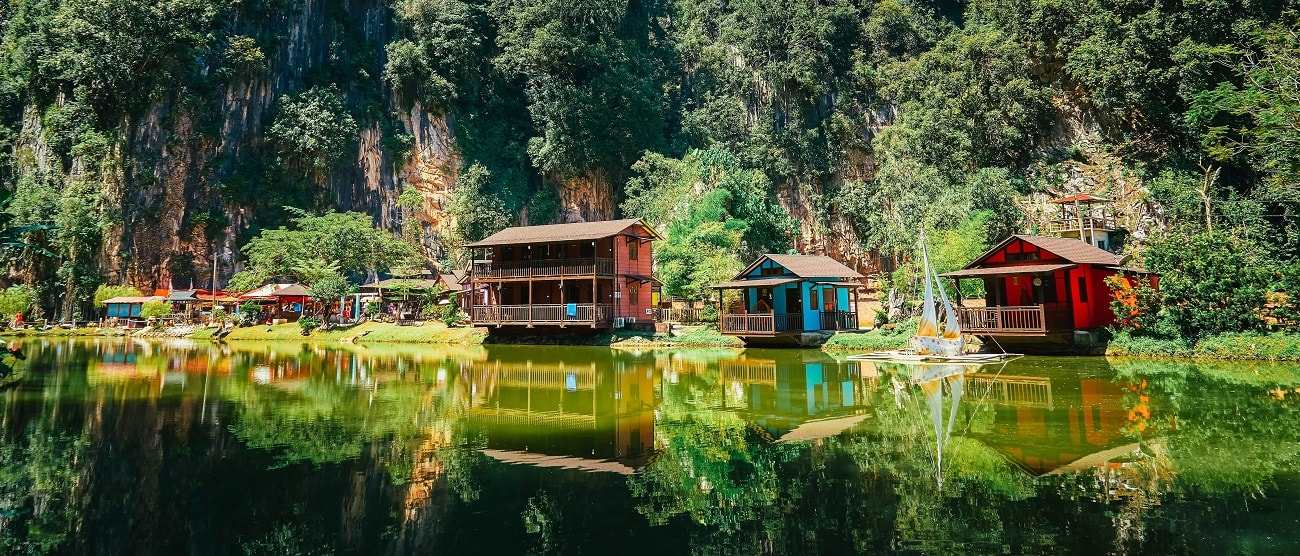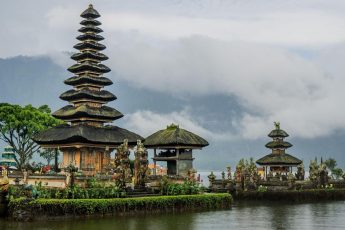Ipoh isn’t just a stop on the way to Penang or the Cameron Highlands. While its fortunes have ebbed and faded, thanks to the tin-mining boom and bust of the early 20th century, this town is now enjoying something of a revival. Surrounded by gorgeous limestone mountains and boasting some of the best cuisine in the country, now is the time to visit and discover all it has to offer!
Get your fill of fantastic fare
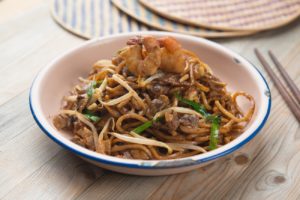
Kway Teow
The food alone is enough of a reason to come to Ipoh. In fact, Lonely Planet has called Ipoh the lesser-known food capital of Malaysia. From food courts and hawker stalls to cafes and restaurants, you’ll be spoiled for choice. Head towards the New Town area on the east bank of the river for more traditional options.
To sample Ipoh’s quintessential dish, bean sprout chicken (nga choy kay), for yourself, make your way to Lou Wong – one of the oldest restaurants in the city. Hints of soy, sesame, and chili are what make this dish of rice noodles, poached chicken and sprouts really sing. Ipoh’s bean sprouts (tauge) are believed to be crunchier and juicier because the water here has a special quality due to the nearby limestone.
The local curry mee is another must-try, which typically has less milk in it; there’s also a dry curry version. Popular eateries serving up curry mee include Xin Quan Fang, Yee Fatt Dry Curry Noodles and Nam Chau Coffee Shop.
Another delicious Ipoh noodle dish is wat tan hor – kway teow in a silky egg gravy, with vegetables, meat and seafood. Grab some at Tuck Kee Restaurant!
Then there’s kai see hor fun, a kway teow noodle soup, made with prawns and chicken and topped with bean spouts and spring onions. Try it at Thean Chun or Restoran Moon De Moon.
Be sure to order Nasi Kandar, a northern Malaysia dish consisting of a number of different curries served with rice. At Yong Suan the nasi kandar is so fabulous that it’s earned the nickname of Nasi Ganja! And to try the local Nasi Ayam (Hainanese chicken), head to Restoran Hainam.
If you’re a dim sum fan then there’s no better place to indulge than at the legendary Ming Court Tim Sum, which gets packed out early on!
To get your fix of sweet treats, make your way to Noor Jahan Bakery. It’s famous for donuts, cakes and buns that you won’t get anywhere else. And to get your hands on Ipoh’s famous kaya puffs (kaya is a green coconut jam) then get ready to queue at Sin Eng Heong bakery.
Don’t leave without sampling the city’s delicious signature drink, white coffee or kopi putih, made with condensed milk. While you can get this almost anywhere, one interesting place to enjoy your Ipoh coffee is Nam Heong Ipoh Soho, where your order will be brought to you by futuristic robotic waiters!
Soak up the street art
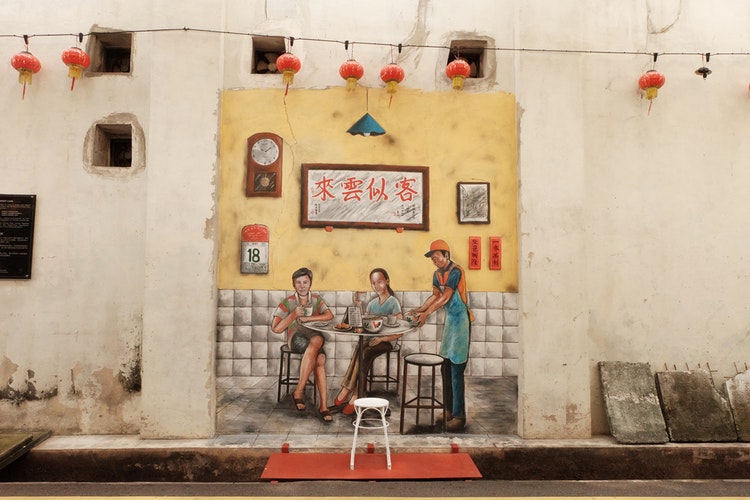
Photo by Mega Caesaria
Grab yourself an art trail map from the tourist information center, or just hit the streets and wander around!
Lithuanian artist Ernest Zacharevic has put his stamp on several places in this part of the world, including Kuala Lumpur, Johor Bahru and Singapore! And he’s done it for Ipoh too. Celebrating Ipoh’s reputation for white coffee, he teamed up with coffee manufacturer Old Town to paint a number of unique coffee-themed murals. You’ll find these along with other funky artworks in the Old Town district – keep your eyes peeled as some are tucked down small alleys or up high on buildings.
Over in the New Town quarter, make your way to Mural Art Lane. The scenes depicted here by homegrown artist Eric Lai portray local history, customs, and family life.
Tour the temples
When the Chinese first arrived at Kinta Valley, they built many temples in the limestone caves. These early settlers found the caves the perfect serene setting for meditation. Today these temples are one of the biggest draws for any visitor to Ipoh. Some of the best known cave temples are Kek Lok Tong, Perak Tong, Sam Poh Tong and Ling Sen Tong.
Perak Tong is known for its giant 40-feet-tall Buddha statue, vivid frescos and Chinese calligraphy. The hilltop location doesn’t hurt when it comes to the views either, except your legs might disagree when climbing the hundreds of steps to the lookout at the pavilion…
Sam Poh Tong is brimming with little Buddha shrines and also boasts a tranquil garden and tortoise pond. It’s billed as one of the biggest in the country.
Ling Seng Tong is known for its colorful facade, which sets it apart from the others. There are also statues representing the 12 animals of the Chinese zodiac along with the more typical homages to the deities.
Finally, at Keh Lok Tong you’ll find a laughing Buddha sculpture and the lush Zen Gardens.
Get acquainted with the museums
Ipoh has museums in spades; your only problem will be picking and choosing which ones to make time for.
Han Chin Pet Soo, once home to the men-only Tin Miners’ Club, offers a glimpse into life as one of the workers who helped build this village into a thriving city. The Museum Darul Ridzuan and Palong Tin Museum are also devoted to the town’s tin mining and forestry heritage.
At the Tea Museum you’ll learn all about Ho Yan Hor Chinese Herbal Tea and the founder it was named after, while the Kong Heng Museum (which is only open weekends) showcases the films of Malaysian director Yasmin Ahmad, who is known for her cross-cultural storytelling.
At the quirky Miniature Wonders Art Gallery, scenes from old time China have been lovingly recreated using tiny figurines made from dough – a must-visit if you have the time.
Also worth a stop is the Geological Museum, which dives into the industrial side of mining and also displays gems, minerals and fossils.
Take in architecture style from bygone times
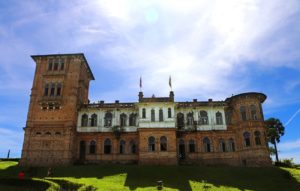
Kellie’s Castle
This quaint city is full of colonial buildings, many of which make up part of the Ipoh Heritage Walk.
The gleaming white Town Hall is ideal for photo shoots while the grand railway station is all sweeping Victorian arches and pillars and has been dubbed the local version of the Taj Mahal.
The Birch Memorial Clock Tower, a monument built to honor the first British resident of Perak state, features an enormous bell and sculpted artwork incorporating Buddha, Moses, and even Darwin.
You can also check out Kellie’s Castle, perched atop a hill and former rubber estate. Scotsman William Kellie Smith set our to recreate his home here but construction halted upon his death. Is believed to be haunted, with hidden passages and tunnels; it was even used as a setting for Anna and the King.
And of course, take time simply to explore the shopfronts and alleys of Old Town, where a new wave of modern cafes and restaurants like Burps & Giggles are popping up and bringing a new flavor to the historic quarter.
As you can see, Ipoh definitely isn’t short of attractions. Don’t miss the local Gerbang Malam night market or a stroll along the riverfront Kinta Front Walk, where the trees are decorated with countless neon lights that make for quite a spectacle. And head up Kledang Hill in the early hours to catch sunrise from the top!

